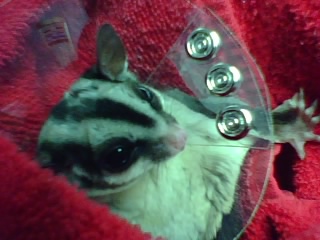After Care & Rehabilitation Instructions for
Sugar Glider with Broken Leg
_______________________________________________________________________________
Diagnosis: A diagnosis of a broken bone can ONLY be made by x-ray. Please ensure that your vet takes an x-ray of the suspected break. Gliders can sustain a wide variety of injuries, so what presents as a broken limb may not, in fact, be a broken limb.
Options for treatment:
SOME breaks can be repaired. We have case studies of gliders having breaks pinned using a needle, but this is very rare and can really only be done if the break is close to the middle of the bone. For breaks close to joints or in smaller bones, they simply cannot be set or repaired in an animal this small. Your vet will tell you if this surgery is an option.
SUGAR GLIDERS DO NOT DO WELL IN A CAST OR SPLINT. Additionally, they have proven to be ineffective in providing a stronger healing/calcification than when a splint or cast is not attempted.
************************************************
IF your glider cannot have the bone repaired through surgery, then follow these recommendations:
Use of a liquid calcium supplement: Ask your vet for a 2-3 week supply of a liquid calcium supplement. This is used IN ADDITION TO your regular diet, which should be rich in calcium. Mix the liquid supplement with the glider’s staple food for a period of time advised by your vet.
Begin or continue using a GOOD glider diet: For further information on the most up-to-date research and information on glider nutritional needs, please see our Glider Gourmet section.
The single best thing you can do to help your glider heal is to feed a diet that has been proven to maintain healthy gliders and to help an ill glider get well. The most commonly used diets are HPW, BML, Priscilla Price’s Pet glider diet, PML and a variety of Green Diets. A balanced diet for a sugar glider includes the use of a staple food (generally a mix that is frozen and dished out nightly), fresh veggies and fresh fruit daily - the diet should include a balanced calcium:phosphorus ratio, not too much or too little protein and an appropriate amount of vitamins and minerals. Live insects are NOT a significant source of protein for the captive glider, and must not be the sole or primary protein source.
Use of a hospital cage: A sugar glider with a broken leg must be confined to a small space and prohibited from climbing. Creating a hospital cage out of a clear Rubbermaid tub with holes drilled in the lid will prohibit jumping and climbing. Put fleece, pouch and food/water dishes on the floor of this home-made hospital cage and keep the glider in this cage for 3-6 weeks (your vet can advise you to the length of time, or you can call the number listed at the end of this form). Do NOT put a wheel or hanging toys in this cage. The glider is encouraged to rest so that the bones can begin to calcify.
While your glider is healing, investigate the CAUSE of the injury. Gliders are experienced and prolific acrobats, so a jump or hard landing does NOT cause a broken bone.
Is your diet sufficient in calcium? Is your wheel safe and approved for sugar glider use? Is your cage made of safe material? Are your cage and play area free of loose strings and items that toes can get caught on? Are your glider’s nails trimmed regularly? Are your sleeping and bonding pouches safely made, with no inside seams and no loose strings? Are all of your toys safe and approved for sugar glider use? Is your cage free of toxic materials?
These are just a few of the questions you have to ask yourself. If you are not sure WHAT is safe for a glider, please check out the websites listed at the end of this form.
***********************************
It is important to restrict the glider’s movements until the bones have completely healed (calcified). This generally takes 5-8 weeks. Do not allow full, unrestricted activity until a follow-up x-ray has confirmed that the bone is healed.
In the VAST MAJORITY of cases, gliders will experience functional return of use of hand or foot (including gripping and climbing) following the complete healing of a broken bone. The bone may not heal PERFECTLY, and depending upon the location of the break, there may be some deformation or limiting of a joint. The glider will independently compensate for most of these issues. If joint mobility or control is limited, slight modifications to the cage can be made to make it a safe environment for the sugar glider to live the remainder of its life.
